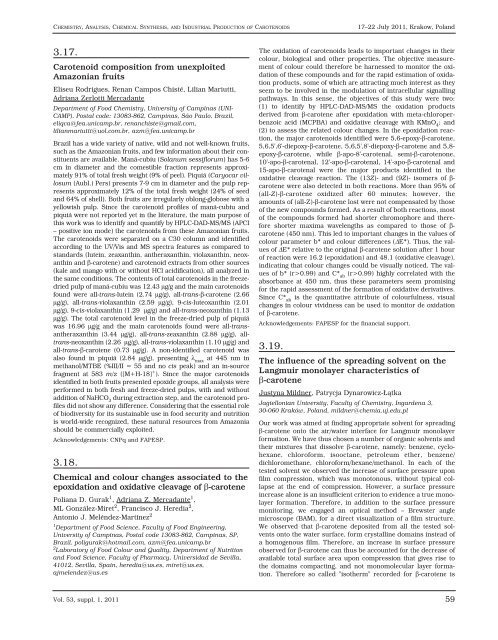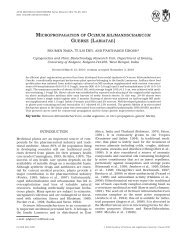ACTA BIOLOGICA CRACOVIENSIA
ACTA BIOLOGICA CRACOVIENSIA
ACTA BIOLOGICA CRACOVIENSIA
Create successful ePaper yourself
Turn your PDF publications into a flip-book with our unique Google optimized e-Paper software.
CHEMISTRY, ANALYSIS, CHEMICAL SYNTHESIS, AND INDUSTRIAL PRODUCTION OF CAROTENOIDS<br />
3.17.<br />
Carotenoid composition from unexploited<br />
Amazonian fruits<br />
Eliseu Rodrigues, Renan Campos Chisté, Lilian Mariutti,<br />
Adriana Zerlotti Mercadante<br />
Department of Food Chemistry, University of Campinas (UNI-<br />
CAMP). Postal code: 13083-862, Campinas, São Paulo, Brazil,<br />
eliqca@fea.unicamp.br, renanchiste@gmail.com,<br />
lilianmariutti@uol.com.br, azm@fea.unicamp.br<br />
Brazil has a wide variety of native, wild and not well-known fruits,<br />
such as the Amazonian fruits, and few information about their constituents<br />
are available. Maná-cubiu (Solanum sessiflorum) has 5-6<br />
cm in diameter and the comestible fraction represents approximately<br />
91% of total fresh weight (9% of peel). Piquiá (Caryocar villosum<br />
(Aubl.) Pers) presents 7-9 cm in diameter and the pulp represents<br />
approximately 12% of the total fresh weight (24% of seed<br />
and 64% of shell). Both fruits are irregularly oblong-globose with a<br />
yellowish pulp. Since the carotenoid profiles of maná-cubiu and<br />
piquiá were not reported yet in the literature, the main purpose of<br />
this work was to identify and quantify by HPLC-DAD-MS/MS (APCI<br />
– positive ion mode) the carotenoids from these Amazonian fruits.<br />
The carotenoids were separated on a C30 column and identified<br />
according to the UV/Vis and MS spectra features as compared to<br />
standards (lutein, zeaxanthin, antheraxanthin, violaxanthin, neoxanthin<br />
and β-carotene) and carotenoid extracts from other sources<br />
(kale and mango with or without HCl acidification), all analyzed in<br />
the same conditions. The contents of total carotenoids in the freezedried<br />
pulp of maná-cubiu was 12.43 μg/g and the main carotenoids<br />
found were all-trans-lutein (2.74 μg/g), all-trans-β-carotene (2.66<br />
μg/g), all-trans-violaxanthin (2.59 μg/g), 9-cis-luteoxanthin (2.01<br />
μg/g), 9-cis-violaxanthin (1.29 μg/g) and all-trans-neoxanthin (1.13<br />
μg/g). The total carotenoid level in the freeze-dried pulp of piquiá<br />
was 16.96 μg/g and the main carotenoids found were all-transantheraxanthin<br />
(3.44 μg/g), all-trans-zeaxanthin (2.88 μg/g), alltrans-neoxanthin<br />
(2.26 μg/g), all-trans-violaxanthin (1.10 μg/g) and<br />
all-trans-β-carotene (0.73 μg/g). A non-identified carotenoid was<br />
also found in piquiá (2.84 μg/g), presenting λmax at 445 nm in<br />
methanol/MTBE (%III/II = 55 and no cis peak) and an in-source<br />
fragment at 583 m/z ([M+H-18] + ). Since the major carotenoids<br />
identified in both fruits presented epoxide groups, all analysis were<br />
performed in both fresh and freeze-dried pulps, with and without<br />
addition of NaHCO3 during extraction step, and the carotenoid profiles<br />
did not show any difference. Considering that the essential role<br />
of biodiversity for its sustainable use in food security and nutrition<br />
is world-wide recognized, these natural resources from Amazonia<br />
should be commercially exploited.<br />
Acknowledgements: CNPq and FAPESP.<br />
3.18.<br />
Chemical and colour changes associated to the<br />
epoxidation and oxidative cleavage of β-carotene<br />
Poliana D. Gurak 1 , Adriana Z. Mercadante 1 ,<br />
ML González-Miret 2 , Francisco J. Heredia 2 ,<br />
Antonio J. Meléndez-Martínez 2<br />
1Department of Food Science, Faculty of Food Engineering,<br />
University of Campinas, Postal code 13083-862, Campinas, SP,<br />
Brazil. poligurak@hotmail.com, azm@fea.unicamp.br<br />
2Laboratory of Food Colour and Quality, Department of Nutrition<br />
and Food Science, Faculty of Pharmacy, Universidad de Sevilla,<br />
41012, Sevilla, Spain, heredia@us.es, miret@us.es,<br />
ajmelendez@us.es<br />
Vol. 53, suppl. 1, 2011<br />
The oxidation of carotenoids leads to important changes in their<br />
colour, biological and other properties. The objective measurement<br />
of colour could therefore be harnessed to monitor the oxidation<br />
of these compounds and for the rapid estimation of oxidation<br />
products, some of which are attracting much interest as they<br />
seem to be involved in the modulation of intracellular signalling<br />
pathways. In this sense, the objectives of this study were two:<br />
(1) to identify by HPLC-DAD-MS/MS the oxidation products<br />
derived from β-carotene after epoxidation with meta-chloroperbenzoic<br />
acid (MCPBA) and oxidative cleavage with KMnO 4 ; and<br />
(2) to assess the related colour changes. In the epoxidation reaction,<br />
the major carotenoids identified were 5,6-epoxy-β-carotene,<br />
5,6,5',6'-diepoxy-β-carotene, 5,6,5',8'-diepoxy-β-carotene and 5,8epoxy-β-carotene,<br />
while β-apo-8'-carotenal, semi-β-carotenone,<br />
10'-apo-β-carotenal, 12'-apo-β-carotenal, 14'-apo-β-carotenal and<br />
15-apo-β-carotenal were the major products identified in the<br />
oxidative cleavage reaction. The (13Z)- and (9Z)- isomers of βcarotene<br />
were also detected in both reactions. More than 95% of<br />
(all-Z)-β-carotene oxidized after 60 minutes; however, the<br />
amounts of (all-Z)-β-carotene lost were not compensated by those<br />
of the new compounds formed. As a result of both reactions, most<br />
of the compounds formed had shorter chromophore and therefore<br />
shorter maxima wavelengths as compared to those of βcarotene<br />
(450 nm). This led to important changes in the values of<br />
colour parameter b* and colour differences (ΔE*). Thus, the values<br />
of ΔE* relative to the original β-carotene solution after 1 hour<br />
of reaction were 16.2 (epoxidation) and 48.1 (oxidative cleavage),<br />
indicating that colour changes could be visually noticed. The values<br />
of b* (r>0.99) and C* ab (r>0.99) highly correlated with the<br />
absorbance at 450 nm, thus these parameters seem promising<br />
for the rapid assessment of the formation of oxidative derivatives.<br />
Since C* ab is the quantitative attribute of colourfulness, visual<br />
changes in colour vividness can be used to monitor de oxidation<br />
of β-carotene.<br />
Acknowledgements: FAPESP for the financial support.<br />
3.19.<br />
The influence of the spreading solvent on the<br />
Langmuir monolayer characteristics of<br />
β-carotene<br />
Justyna Mildner, Patrycja Dynarowicz-Łątka<br />
17–22 July 2011, Krakow, Poland<br />
Jagiellonian University, Faculty of Chemistry, Ingardena 3,<br />
30-060 Kraków, Poland, mildner@chemia.uj.edu.pl<br />
Our work was aimed at finding appropriate solvent for spreading<br />
β-carotene onto the air/water interface for Langmuir monolayer<br />
formation. We have thus chosen a number of organic solvents and<br />
their mixtures that dissolve β-carotene, namely: benzene, cyclohexane,<br />
chloroform, isooctane, petroleum ether, benzene/<br />
dichloromethane, chloroform/hexane/methanol. In each of the<br />
tested solvent we observed the increase of surface pressure upon<br />
film compression, which was monotonous, without typical collapse<br />
at the end of compression. However, a surface pressure<br />
increase alone is an insufficient criterion to evidence a true monolayer<br />
formation. Therefore, in addition to the surface pressure<br />
monitoring, we engaged an optical method – Brewster angle<br />
microscope (BAM), for a direct visualization of a film structure.<br />
We observed that β-carotene deposited from all the tested solvents<br />
onto the water surface, form crystalline domains instead of<br />
a homogenous film. Therefore, an increase in surface pressure<br />
observed for β-carotene can thus be accounted for the decrease of<br />
available total surface area upon compression that gives rise to<br />
the domains compacting, and not monomolecular layer formation.<br />
Therefore so called "isotherm" recorded for β-carotene is<br />
59












